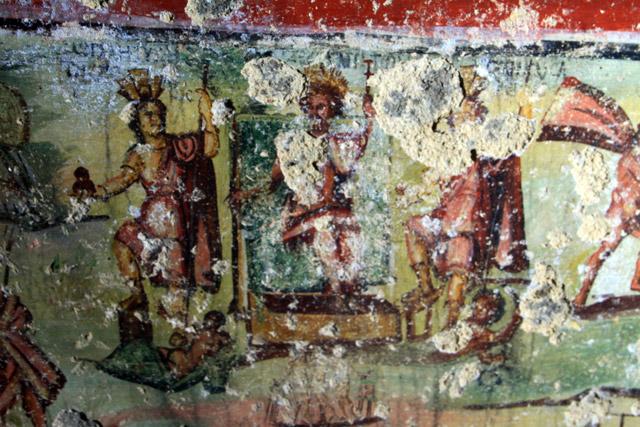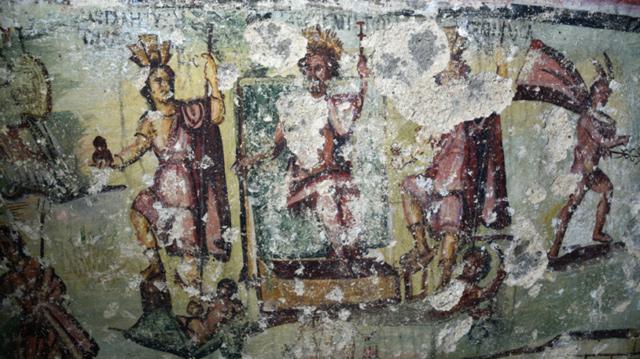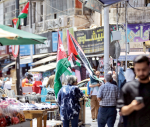You are here
Findings from Irbid's Bait Ras tomb are 'unique in region'
By Hana Namrouqa - Apr 04,2018 - Last updated at Apr 04,2018

Minister of Tourism and Antiquities Lina Annab discusses the archaeological findings in Irbid on Tuesday (Photo courtesy of DOA)
AMMAN — Studies and excavations on Irbid Governorate’s Bait Ras tomb revealed that the archaeological site is "unique on a regional level", featuring Greek and Aramaic inscriptions and many frescoes, archaeologists said on Tuesday.
The Bait Ras tomb happened to be "virtually intact", the archaeologists said, indicating that it dates back to the Roman period, specifically in the period from 1st-3rd century AD.
The Jordan Department of Antiquities (DoA) and the USAID’s Sustainable Cultural Heritage Through Engagement of Local Communities Project (SCHEP) shared the Bait Ras tomb project’s initial findings and future plans during a ceremony at the site of the tomb.
Discovered by sheer accident in November 2011, the tomb’s walls are covered with elaborate paintings and inscriptions of significant historical value, DoA General Director Monther Jamhawi said.
“The findings are interesting and important. The tomb is unique in the region due to its size and the number of frescoes covering its walls,” Jamhawi told The Jordan Times over the phone.
He noted that the tomb, which stretches over 60 sq.m, has undergone extensive documentation, conservation and scientific studying by a large multinational team of experts from Jordan, Italy, France and the US.
"The Bayt Ras Tomb Project is unique as it represents a strategic partnership between the DoA and international institutions with more than 20 specialists in the conservation and preservation of cultural heritage, especially in wall paintings and inscriptions," Jamhawi underscored.
The tomb was a burial place for a Roman dignitary, he said, highlighting that inscriptions show that the dead was admired by society and of a high social status.
“Studies will continue to reveal more findings and, once work is complete, the site will be added to the trail of archaeological sites in the area,” Jamhawi highlighted.
Minister of Tourism and Antiquities Lina Annab stressed the importance of the archaeological finding, saying “the discovery of the tomb will boost the country’s image and enrich the experience of tourists in Irbid”.
Meanwhile, Bayt Ras Tomb project coordinator Jehad Haron said that the discovery of the tomb sheds light on a significant period of Jordanian history during the Roman era, especially since it contains 52 Greek and Aramaic inscriptions and dozens of frescoes with accurate details that were not mentioned before in historical records.
SCHEP involved local community members in every step of the process, training 25 persons from the Irbid DoA staff and university graduates in the field of conservation and restoration of archaeological monuments, according to the statement.
A team of experts from the Higher Institute for Conservation and Restoration in Rome, the French National Scientific Research Centre and the Italian National Institute for Environmental Protection and Research were also involved in the project.
Barbra Porter, director of the American Centre for Oriental Research said that, when such important Roman remains were discovered by chance, preservation can be difficult, noting that the team and the community managed to overcome many difficulties and protect the site through the support of the local community and its cooperation with the partners in the project
"This is why we are happy to implement such projects and create jobs for the community,” Porter said in a statement, noting that USAID SCHEP is dedicated to economic and community development through cultural heritage preservation and education in underserved communities across Jordan.
Related Articles
AMMAN — The Department of Antiquities (DoA) will open a recently discovered archaeological site in Irbid’s Beit Ras area next month, the dep
AMMAN — A recent webinar titled "Heritage vs Development: The Bait Ras Tomb Project 2017–2019" shed light on excavations spanning four decad
AMMAN — After the COVID hiatus, USAID’s “Sustainable Cultural Heritage Through Engagement of the Local Communities Project” (SCHEP), which b


















